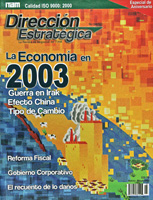 By: Dr. Marco Alberto Huidobro
By: Dr. Marco Alberto Huidobro
For decades, the governments of many countries have explored different ways to improve companies’ access to bank credit. In Mexico, one of the most popular strategies has been government participation in the credit market in order to channel financial resources from government-run development banks and promotion trusts to private companies.
But for years, there have also been questions about the role that government financial institutions play in promoting access to credit for private companies; some believe, for example, that their actions benefit primarily state-owned companies themselves, or that they do not share information that would encourage more lending by private banks. There even seems to be a lack of evidence that they encourage private banks to seek out new clients.
Following this debate, Cotler said that “if development banks were placing resources in sectors with little access to commercial bank credit, it should be possible to detect significant differences between development bank and commercial bank borrowers.” This is particularly significant since, if there is no difference between the type of borrowers served or credits offered by private and government banks, there would be little economic justification for government intervention in this market. In other words, if development banks simply replicate commercial bank practices, by definition they would not be promoting either increased access or improved efficiency in the credit market.
With this in mind, our study was developed based on the following research question:
Are there substantive differences between the characteristics of borrowers served and credits granted by the commercial banks and development banks to companies in the private sector?
The initial hypothesis of this paper is that there are no significant differences between the borrowers or the credits extended by development banks and commercial banks.
To verify this hypothesis, we analyzed the recent status of bank financing to companies in Mexico (what is called Bank Commercial Lending), based on an extensive database of more than 1.6 million records of loans extended by private and government banks as of December 2007. The information is nationwide in coverage and incorporates loans to companies, individuals with business activity and government entities, to fund productive activities in the farming, mining, manufacturing, industrial, retail, services and financial services industries. The main interest of this paper is in loans to private-sector companies and individuals with business activities.
Our analysis contributes evidence that suggests the existence of significant differences between the types of borrowers and the loans granted by commercial and development banks in Mexico. On a more detailed level, the comparison clearly indicates the following:
- For any size of company, commercial banks lend more on average than development banks.
- In general, there is a direct relationship between the average size of the credit and the size of the borrower.
- In general, Mexican banks do not require collateral on their loans, and almost all cases of collateralized loan corresponded to commercial banks, which also demanded the highest degree of preference on that collateral.
- Government banks apply lower interest rates than their private counterparts, and apparently not because of lower funding costs.
- Generally speaking, government banks offer longer repayment terms than commercial banks, and there is a more marked difference in the micro and mid-sized borrower segments.
- Neither government nor private banks lend to borrowers in existence for less than two years, and both concentrate their loans on businesses that have been operating for more than 15 years. Therefore, it would seem that development banks do not necessarily improve access for younger borrowers to the bank credit market.
- More than 95% of bank borrowers are in urban areas, which could indicate a possible exclusion of rural areas from bank credit. But it may also reflect a heavy concentration of added value generation in urban areas, or the concentration of bank borrowers’ corporate domiciles in urban areas, meaning they tend to legally establish themselves in cities.
- Most of commercial bank financing goes to support borrowers’ short-term needs, whether for working capital with no specific use, or for other immediate needs, but not necessarily for investment, expansion or modernization of their productive facilities; this may inhibit their future possibilities for growth and increased competitiveness.
Subsequently, the study extends the initial hypothesis and argues that there are no relevant differences between the key factors that determine the interest margins that private and government banks charge on their loans to the private business sector.<br
Specifically, the document empirically studies whether development banks replicate the lending criteria followed by private banks by comparing how their interest rates, or better yet, their net interest margins, respond to differences in the same set of characteristics of loans and borrowers.
In examining loan characteristics, the study took into account the type of lending institution, the existence of collateral backing the loan, the balance, term and use of the proceeds. The characteristics of borrowers that were taken into account for the study were: whether it was an individual or corporation, its years of operation, size, economic activity and whether it was domiciled in a rural or urban area.
Once again, the study found signs of significant differences between the main factors that determine the interest margins that private and government banks assign to private-sector borrowers. Therefore, the results refute the original hypothesis and enable us to affirm that government banks do, in fact, perform a function that does not necessarily respond to the principles of private-sector profitability guiding commercial banks. In general, we found that the main factors that determines interest margins were, by order of importance, the following:
- The type of bank lending institution-private banks apply much higher interest margins than development banks.
- The type of borrower-corporate borrowers pay a lower interest margin than individuals.
- Collateral-borrowers that put up collateral are assigned considerably lower interest margins than those who do not.
- The size of the borrower-the larger the borrower, the lower the interest margin.
- The use of the proceeds-loans that support liquidity requirements were assigned the highest interest margins.
- The economic activity of the borrower-interest margins rise according to borrowers’ occupation in the primary, secondary and tertiary sectors, in that order, and the highest interest margins are charged to retail and services, in general.
Furthermore, to understand some of the differences in determining factors for both types of bank, the study proposes the following classification:
Institutionally determined differences. Commercial banks offer the lowest interest margins to borrowers in the farming sector; development banks offer the lowest interest margins to financial sector borrowers. These differences are determined exogenously, because the government has for years decided that development banks that serve the agricultural sector (special agricultural trusts called FIRA and Financiera Rural) act as second-floor lenders. The financial industry (which in the database used refers particularly to non-bank financial intermediaries) channels preferential funding, primarily and above all from Nacional Financiera, to companies and individuals engaged in activities outside of the primary sector.
Differences in the term of the loan and the use of the proceeds. Development banks set interest margins significantly lower than those set by private banks, on loans at terms longer than two years, as well as those for the purposes of investment, expansion or modernization of protective facilities, which is compatible with the traditional functions of development banks. However, the benefits of this practice may be very limited, because less than half of loans by public banks were placed at terms of more than two years. In fact, both private and government banks assigned more than 95% of their loans at terms of less than five years.
Differences of degree. Some of the differences are actually merely differences of degree or magnitude, because they follow the same direction. This is the case of the observed reductions in interest margin as the size of the borrower increases. On the other hand, neither commercial or development banks lend to borrowers with less than two years of business experience, and both concentrate their loans in corporations and individuals operating for more than 15 years.
Conclusions
There are three central conclusions to this paper. First, Mexican development banks do not always act in the same way as private banks in their lending practices. Specifically, there are some differences between the characteristics of the credits they extend and among the borrowers that each type of bank serves. Second, there is not enough evidence to affirm that government banks set the interest margins on their loans in the same way that commercial banks do. Third, this does not necessarily mean that development banks are mitigating imperfections in the market that create problems of credit accessibility.
Accordingly, Doctor Huidobro’s study contributes empiricl evidence for evaluating the contribution of government banking institutions to the lending market in Mexico.?
References
Werner, M. (1994). “La banca de desarrollo 1988-1994: balance y perspectivas”, Comercio Exterior, Vol. 44, No. 12, diciembre.
Armendáriz, B. (1999). “Development Banking”. Journal of Development Economics, Vol. 58, February.
Benavides, G. y Huidobro, A. (2009). “Are Loan Guarantees Effective?: The Case of Mexican Government Banks”. Well-Being and Social Policy, Vol. 5, No. I, México.
Cotler, P. (2000). “El comportamiento de la banca de desarrollo en México y su compatibilidad con la política económica”. En El futuro de la banca de desarrollo: el reto del fomento económico. Federalismo y desarrollo, Año 13, No. 69, julio-agosto-septiembre, Banco Nacional de Obras y Servicios Públicos, México.
Sapienza, P. (2004). “The Effects of Government Ownership on Bank Lending”. Journal of Financial Economics, No. 72.
































4 Comments
¿Cuáles son las fuentes que usaron? Es importante saberlo.
Hola. Es muy pertinente el comentario. Para su debida respuesta, sugiero atentamente a Fernando Huizar -y a todos los interesados- consultar la tesis que con los mismos datos se encuentra disponible en la biblioteca del ITAM.
El acceso al crédito en una economía es un factor importante para estimular el crecimiento
y desarrollo económico , Es preocupante ver estos datos de la tendencia de la banca de desarrollo. Otorgar exclusivamente créditos a empresas con mas de 15 años de vida;
No sirve para disminuir el acceso al crédito en el mercado. Deja de lado el 80% de la aportación al PIB por parte de las PYMES. Es factible que la banca de desarrolle modifique sus políticas para otorgar créditos.
Es muy interesante comparar los resultados con lo que supuesta mente se quiere hacer así se puede hacer un llamado de atención al gobierno de sus políticas.
Saludos..
TOTALMENTE DE ACUERDO CON LAS OBSERVACIONES DE DAVID ESTRADA. PRECISAMENTE EN ELLO RADICA PARTE DE LA IMPORTANCIA DEL ESTUDIO EN QUE SE BASA ESTE ARTÍCULO Y ESTOS COMENTARIOS. POR CIERTO, ACTUALMENTE ESTA EN PROCESO UNA VERSIÓN REVISADA DE ESE ESTUDIO.